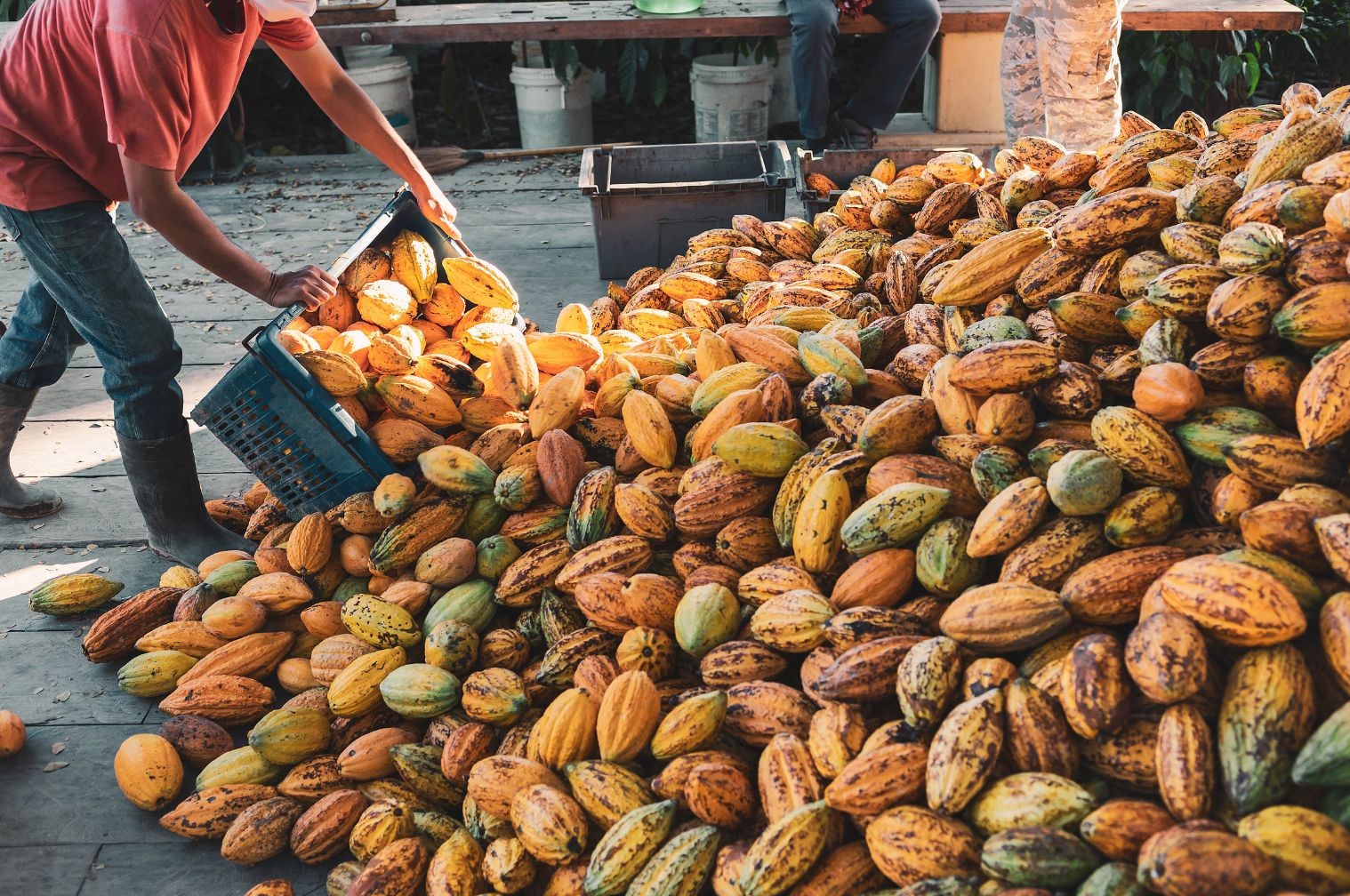Cocoa Farmers’ Livelihood Challenges in West African
1. Cocoa’s Bitter Reality
The reality behind a very popular product: Cacao
The largest cocoa-producing countries
Over 90% of the world’s cocoa comes from an estimated 5 to 6 million smallholder farmers, with West Africa reigning supreme in production (1,2,3). While Cote d’Ivoire and Ghana are the leading producers, contributing roughly 50% of the global output, countries like Nigeria, Cameroon, and Ghana collectively account for around 70% of global production, and Nigeria, as a major cocoa producer, contributes approximately 7% to this output (4).
However, this production comes at a human cost. Most West African cocoa farmers are deeply impoverished, with limited education and meager incomes. Thus, they use schoolchildren and rely on family members for their farming operations. In Nigeria, the aging cocoa plantations, often passed down through generations, suffer from declining productivity due to a lack of resources for rehabilitation (5,6).
Child labor in the cacao production
This low income forces many farmers to rely on family labor, including children, who are often denied the opportunity to attend school to keep their price competitive or deforestation to cope with their economic hardships (7). In Ivory Coast, the government made it mandatory for children to be in school till age 16 and made it illegal for under 16 years of age to work on cocoa farms (8). In Ondo state, Nigeria, the government lauded the Lutheran World Relief project to curb child labor in the cocoa supply chain (9).
2. Cocoa Farmers’ Livelihood Challenges
Limited Income and Lack of Resources
In Nigeria, from a livelihood study of 50 farmers in Ondo state, the largest cocoa-producing region in Nigeria, approximately 76% of the households depends on cocoa as their primary source of income, and approximately 45% of the households have monthly income of 25,000-50,000 naira. In contrast, only 8.16% had income from their cocoa farm exceeding 100,000 nairas (10, 11). For many cocoa farmers, particularly those with small plantations, life is a constant struggle. They rely solely on their cocoa income, often living below the poverty line and lacking access to government support (12).
Cycle of Poverty in the Cacao Production
The Harsh Reality for West African Cocoa Farmers
The cycle of poverty perpetuates, trapping farmers in a struggle for survival while their cocoa fuels billion-dollar industries. The poverty and lack of education among cocoa farmers also negatively impact their health, nutrition, and social well-being. For instance, many cocoa farmers and their families suffer from food insecurity, malnutrition, and diseases.
The unfair practices of middlemen further worsen the poverty faced by cocoa farmers. These intermediaries collect cocoa beans from numerous farmers and sell them to large processing companies. Unfortunately, the inequality and frustration that farmers experience are common among rural cocoa producers. They often receive meager profits from their harvest, with many earning less than $1 a day (14). The money they receive simply doesn’t translate to a decent living.
Several factors contribute to this harsh reality. Some of the problems affecting the livelihoods of rural cocoa farmers include but are not limited to:
- dependence solely on the cocoa farm for their livelihoods, which restricts income diversification and makes farmers vulnerable to price fluctuations,
- high input costs, especially the rising cost of fertilizers, pesticides, and other farming essentials, further strain their finances,
- small farms with corresponding yield and low cocoa revenue, the poor yield from old trees,
- climate change and the unpredictable weather patterns which pose additional threats to crop health and productivity,
- limited choice of diversification, which limits farmers’ ability to spread risk and create additional income streams and
- market-related constraints, which expose them to limited access to fair markets and exploitative middlemen, can further reduce profits, among others (13).
3. Global cocoa industries
Africa’s Dominant Role and Production Challenges
While global cocoa production reached a new high of 4.938 million metric tons in 2022/2023, a 2.4% increase year-over-year, the future looks uncertain. Unpredictable weather patterns, likely linked to climate change, are disrupting production in major cocoa-growing regions, threatening a vital source of income for millions.
Unpredictable Weather and Price Fluctuations
Africa dominates cocoa production, with Ivory Coast, Ghana, Cameroon, and Nigeria contributing over 70% of the world’s cocoa (27). However, these powerhouses are facing significant challenges. The world’s leader, Ivory Coast, has seen a concerning 28% decrease in shipments compared to last year due to low rainfall (28). The second-largest producer, Ghana, has been forced to slash its initial estimates for the 2023/2024 season due to similar weather issues (29).
Even Nigeria, the 5th largest producer, hasn’t been spared. Smallholder farmers in West Africa face production constraints due to mealybug infestation, which is a vector for the swollen shoot virus disease of cocoa, and weather issues (30,31,32). And production may not be able to meet global cocoa demand.
Farmers vs. Chocolate Giants
Exports in January 2024 dropped by 15% year-over-year to 36 941 MT (27) and further dropped to 26,103 MT in February (30). In Nigeria, cocoa has risen above $10,150 on the intercontinental exchange, and a ton is now sold for 8 million naira from 1.8 million naira in December 2023. The lower production has driven up cocoa prices. While this might seem positive for farmers in the short term, the situation highlights a deeper problem: unequal distribution of profits within the cocoa industry. The global cocoa industry boasts a value of $200 billion annually (33).
However, despite producing the bulk of the cocoa, West African countries capture only a fraction of this wealth, earning less than $10 billion annually (33,28,31). The issue lies in fixed pricing models. Multinational chocolate manufacturers often pay cocoa farmers a set price, leaving them with minimal profit even when market prices rise. Farmers essentially become price takers, not price setters.
References
- worldcocoafoundation.org
- statista.com
- cacaonet.org
- foodispower.org
- Olaiya et al., 2022
- Somarriba et al., 2021
- Tribune Online
- Johnson, 2022
- Business Day, 2024
- nigerianqueries.com
- future-agricultures.org
- vanguardngr.com/2024/04
- www.unsdsn.org
- 27-33
- Odhiambo, 2024
- Asplund, February, 2024
- https://www.reuters.com/
- Adesina, 2024
- African business/2024/04/
- Ademola, 2024
- Essiet, 2024
Further reading
Cacao Certification as a driving force for adopting Improved Farming Technologies in Ghana, Africa
Cacao Soil requirements and Planting distances
Cacao Fertilization and Nutrient Requirements
Cacao Variety Selection and Propagation – What are the 3 major variety of cacao?
Yield, Harvest, Handling and Storage of Cacao
Cacao production: Challenges and Management Strategies
Sales, Trading, and Shipping Cocoa Beans
Why Ghanaian Cocoa Farmers turn towards Sustainable Agriculture Practices










































































